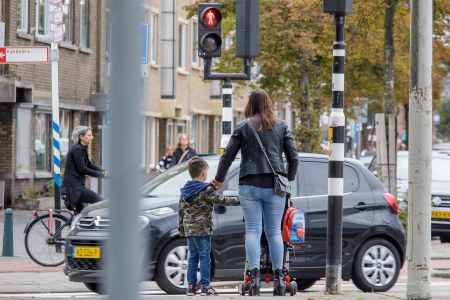Didactic principles
The following general didactic principles also apply to traffic education [3]:
- The motivation principle: learning is faster and more thoroughly when pupils are intrinsically motivated to learn.
- The integration principle: the material taught must be consistent with the pupil’s existing knowledge. What has been learned must also be applicable in other situations (transfer).
- The visualisation principle: lessons should make maximum use of sensory perception.
- The activation principle: it is important to have pupils actively participate in lessons.
- The repetition principle: repeating the subject matter ensures consolidation, repetition in different contexts is beneficial, as is spaced repetition.
- The differentiation principle: it is important to pay attention to the differences between pupils in interest, learning pace and intellectual base.
Teaching formats
Teaching formats are ways of delivering subject matter to pupils. So, it is not about what is taught, but about how it is taught. Which format is best, depends on what and who you want to teach or train. In traffic education, there is a distinction between, for example [3] theoretical and practical teaching formats, and between group training and individual training.
Theory versus practice
Knowledge about traffic rules can, in principle, be transferred in class. For the actual application of these rules and for learning safe behavioural strategies, practising in real traffic is indispensable for young children, at least in the first years of primary education. They cannot yet translate theoretical knowledge about rules or desired behaviour into actual behaviour in real traffic. As children get older, this becomes easier. Practising remains important, however, but it can increasingly be done in a simulated traffic situation, for example in the schoolyard, or with scale models or virtual reality.
Group training versus individual training
In group education, the subject matter is offered to a group of learners at the same time. This is the case, for example, in schools and adult courses. The size of the group varies greatly. The advantage of group education, besides efficiency, is that the students can learn from each other, for example in discussions or when doing assignments together. Individual education involves a one-to-one relationship between student and teacher. This is usually done for practising very specific skills where mistakes during the learning process can have serious consequences. In such cases it is crucial that the teacher can intervene in time. The best-known example of individual traffic education is practical driver training.
Use of teaching material and (new) media
Traditionally, traffic education uses illustrations with photos and videos, sometimes scale models or traffic situations recreated in the schoolyard. New technologies make it possible to adopt a more interactive and realistic approach on an individual level, for example using virtual reality (VR) and augmented reality (AR) techniques. Several studies have shown that children behave more safely after training with VR or AR, or at least when this is also measured with AR or VR [19] [20] [21]. To what extent VR and AR methods also have behavioural effects in real traffic has not/barely been studied [22]. The same is more or less true for serious gaming on a tablet or via VR/AR [23] [24] [25].
Especially for (young) adults, there are also e-learning or online courses (distance learning via Internet or applications) in the field of road safety. Effects of such courses have rarely been studied, but evaluation of an online hazard perception training for novice drivers shows that positive effects are possible [26].
